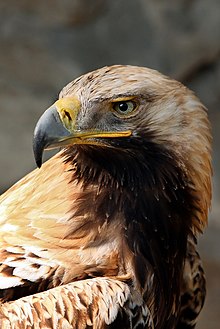By Guille Mayor and Elchin
Sultanov, Tue, 12/04/2016 - 09:07
 The Eastern
Imperial Eagle is listed as Vulnerable on the IUCN Red
List. Its global population estimates range from 3,500 to 15,000
individuals. This embattled bird is a lowland species whose population is
globally declining and that has been pushed to higher altitudes by persecution
and habitat loss in Europe. In central and eastern Europe, it breeds in forests
up to 1.000 m above sea level, in steppe and agricultural areas with large
trees, and nowadays also on electricity pylons.
The Eastern
Imperial Eagle is listed as Vulnerable on the IUCN Red
List. Its global population estimates range from 3,500 to 15,000
individuals. This embattled bird is a lowland species whose population is
globally declining and that has been pushed to higher altitudes by persecution
and habitat loss in Europe. In central and eastern Europe, it breeds in forests
up to 1.000 m above sea level, in steppe and agricultural areas with large
trees, and nowadays also on electricity pylons.
Breeding sites are threatened by
intensive forestry in the mountains, and by the shortage of large indigenous
trees in the lowlands. Other threats are shortages of small and medium-sized
prey species, loss of habitat to agriculture, human disturbance of breeding
sites, nest robbing and illegal trade, shooting, poisoning and electrocution by
powerlines.
Neighbouring countries Georgia
and Azerbaijan are doing their bit to save this species from extinction.
In Georgia, the species has its
main breeding grounds in the east of the country, a vast bushy steppe and
farmland area. According to recent surveys, no more than 40 breeding pairs
remain in the country, mainly restricted to nesting in riverine forests and
electric pylons due to the lack of suitable trees to build nests in throughout the
land.
Since November 2015, SABUKO (Society
for Nature Conservation) is carrying out conservation activities to improve the
status of the Eastern Imperial Eagle (Aquila heliaca) through direct
conservation measures, awareness raising and education.
Before the start of the project,
funded and supported by CLP (Conservation Leadership Programme), several
breeding surveys were carried out during 2014 and 2015 to assess the population
size of the Eastern Imperial Eagle in Georgia and the locations of the nests.
Several abandoned electric pylons were also checked for suitability to install
artificial nests, as the species is known to nest in them in some countries in
the Balkans.
No comments:
Post a Comment